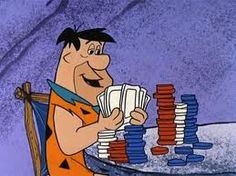Blackjack was invented in the Stone Age, in the prehistoric town of Bedrock. You’ve probably seen the documentary where Fred Flintstone and Barney Rubble play cards with their friends – the Water Buffalos. The cards are chiselled slates and very, very heavy…
You think I’m pulling your leg? Well, you’re right! Though Fred Flintstone did have a gambling problem, Bedrock and its inhabitants are, just as The Flintstones theme song says, “a page right out of history”. The Flintstones is not a documentary but a very popular 1960s animated TV series. But why did I make this parallel between fictional characters and one of the most played and loved casino games today?
 Well, no one can tell when and where blackjack was invented. Certainly, its history couldn’t be pinned down to a single person, event or a year. Search for the history of blackjack online and you’ll be bombarded with titbits of information. In their attempt to clarify things, those sites have created chaos and misinformation. But have no fear, we’re here! And we’ll tell you all you need to know without burdening you with too much information.
Well, no one can tell when and where blackjack was invented. Certainly, its history couldn’t be pinned down to a single person, event or a year. Search for the history of blackjack online and you’ll be bombarded with titbits of information. In their attempt to clarify things, those sites have created chaos and misinformation. But have no fear, we’re here! And we’ll tell you all you need to know without burdening you with too much information.
There are those who argue that some kind of blackjack was played as early as the Roman Empire but, though the Romans are famous for their gambling, there is no evidence of that. Let’s assume it’s true for a moment. What it means is that the Romans would have played the game using wooden blocks with numbers on them. Why? Because playing cards appeared after the invention of the Gutenberg press (circa 1440). It’s funny how Johannes Gutenberg, who became famous for printing the first book, also printed the first deck of cards.
So, from mid-15th century on, the world had the deck of cards but what about the rules we all know? Some historians insist that blackjack is a modified form of a game that was played in Italy, called “31”. However, the rules of that game were quite different from those of BJ. A game similar to the Italian one was played in Spain. The Spanish game was called “21” and that’s why it’s generally considered the one on which blackjack was based. The Spanish “21” game is also responsible for the first official mention in historical documents. The document in question is a story by Miguel de Cervantes. Interestingly, the “greatest writer in the Spanish language”, famous mostly for his novel Don Quixote (1605), was a gambler himself.
Yet another group of people insist that blackjack was born in France, some time around the French Revolution (1789-1799). The French game resembles blackjack much more, both in its rules and its name – Vingt-et-Un, the French for “Twenty-one”. Anyway, the French should mostly be commended for taking the game to the New World in the 19th century.
 In the United States, the game became what we know it to be today. That’s also where the name “blackjack” was established. In the early days, a combination of an Ace of Spades with either a Jack of Clubs or a Jack of Spades that appeared in the player’s initial hand had the best payout – 10:1. The fact that both clubs and spades are black gave the name “Black Jack”. The game really flourished in the United States.
In the United States, the game became what we know it to be today. That’s also where the name “blackjack” was established. In the early days, a combination of an Ace of Spades with either a Jack of Clubs or a Jack of Spades that appeared in the player’s initial hand had the best payout – 10:1. The fact that both clubs and spades are black gave the name “Black Jack”. The game really flourished in the United States.
The next big step in the history of blackjack, still called “21” today, was the appearance of online casinos. Now everyone can play blackjack no matter where they are. What’s more important, you can also make some cash while having fun. There are some important things to consider first, though, so I’d strongly recommend reading what the experts have to say about safety and choosing the right casino to play at. Have a look at realmoneyonlineblackjack.co.uk for many useful tips that will save you both time and money.
